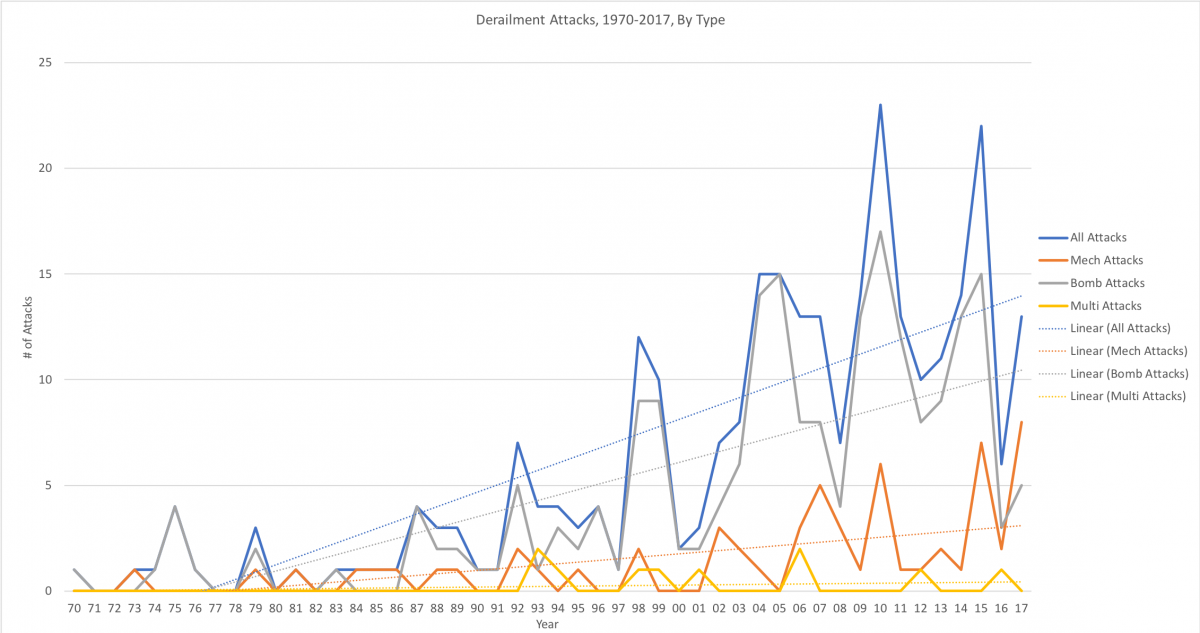- 408-924-7560
- mineta-institute@sjsu.edu
- Donate
New MTI Research Examines Terrorist and Other Extremist Attacks Against Rail Targets
In July 2017, both the Islamic State of Irag and (greater) Syria (ISIS) and al Qaeda in the Arab Peninsula (AQAP) urged their followers to derail trains around the world. AQAP even provided detailed instructions in their online magazine regarding how to make a derailment device. But did this lead to an uptick in derailment attempts over the past year? What has been the overall pattern and trends related to rail sabotage and attacks over the past few decades? New research, Train Wrecks and Track Attacks: An Analysis of Attempts by Terrorists and Other Extremists to Derail Trains or Disrupt Rail Transportation from the Mineta Transportation Institute’s (MTI) National Transportation Security Center examines these questions.
Brian Michael Jenkins and Bruce R. Butterworth oversee MTI’s database of all terrorist and serious criminal attacks against public surface transportation, including rail. Since 1970, there have been more than 1,000 attempts to derail trains and otherwise attack rail infrastructure (see Figure below). Of the 282 attempts to derail trains, 42% led to derailment with more than 1,000 total fatalities and over 3,000 total injuries.
“Derailments are intended to cause casualties,” says Jenkins, “while attacks on tracks and other right-of-way infrastructure are primarily intended to cause disruption and attract attention.”
In order to examine differences in motives, objectives, and modes of operating, Jenkins and Butterworth looked at four specific groups of perpetrators: an assemblage of anarchist and environmentalist extremists in Europe; Maoist guerrillas in India; separatist insurgents in southern Thailand; and jihadists worldwide. According to Butterworth, “these particular attackers were chosen because they have engaged in continuing campaigns which account for approximately one-quarter of attacks since 1970.”
Although derailments have increased over time, these types of attacks have not increased nearly as much as all other attacks on passengers in all surface transportation targets (including passenger trains and stations, buses and bus stations and stops, and passenger ferries and ferry terminals). This suggests that adversaries are increasingly going after surface transportation targets, but are concentrating on easier modes of attack.

ABOUT THE MINETA TRANSPORTATION INSTITUTE
At the Mineta Transportation Institute (MTI) at San Jose State University (SJSU) our mission is to increase mobility for all by improving the safety, efficiency, accessibility, and convenience of our nation's’ transportation system through research, education, workforce development and technology transfer. We help create a connected world. MTI was founded in 1991 and is funded through the US Departments of Transportation and Homeland Security, the California Department of Transportation, and public and private grants. MTI is affiliated with SJSU’s Lucas College and Graduate School of Business.
###
Contact:
Irma Garcia, MTI Communications & Workforce Development Coordinator
408.924.7560
irma.garcia@sjsu.edu
-
Latest Research
Contact Us
SJSU Research Foundation 210 N. 4th Street, 4th Floor, San Jose, CA 95112 Phone: 408-924-7560 Email: mineta-institute@sjsu.edu





